Toho Breaks the Rules in "Godzilla:
Final Wars"
The Godzilla Series > Final Wars > Smog Monster
The Captain
always oversteps his bounds, taking on any challenge presented
- journalistic or otherwise. For example, expiration dates
on milk cartons are always padded by at least ten days, his
rule of thumb goes.
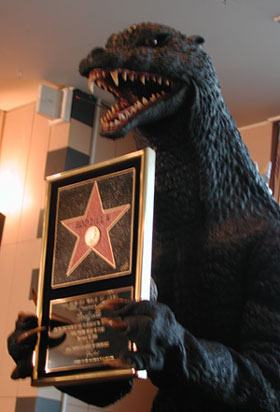 This
week he is battling the "King of Monsters" in what
might be the lizard's final movie. Join the Captain, and find
out just what Godzilla's breath smells like.
This
week he is battling the "King of Monsters" in what
might be the lizard's final movie. Join the Captain, and find
out just what Godzilla's breath smells like.
Godzilla has now toppled his
last building...well, maybe.
"Our goal was not to create the last Godzilla
film, but rather to make the utterly best film. In other words,
a film that nobody would be able imitate," said Shogo
Tomiyama, producer of Godzilla: Final Wars for Toho
Studios, during a recent news conference at the Foreign
Correspondents' Club Japan.
For Toho, "best" means pulling out
all the stops in this the latest in a series of films that
started fifty years ago and has continued with a revolving
cast of monster opponents for the fire-breathing
beast to tackle.
"Because this was going to be the last
Godzilla film I thought we could break all the rules,"
said Ryuhei Kitamura, the 35-year old director. "And
I think we did so; I think we have created a type of Godzilla
film that has never existed before."
It's been a busy past month for the "King
of Monsters." Not only was he putting the final touches
on Final Wars but found time to stomp on over to Hollywood
to see his star set in concrete in the Walk of Fame. Whether
he has clawed at Gamera for the last time is still not completely
certain. What is clear is that the charm of Toho's unique
special effects, which amount to a man plodding around in
a rubber suit, and the monster's message for peace will continue
to appeal for generations.
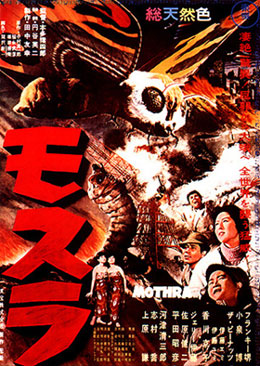 This
latest feature broke the bank in a number of ways. The 2 billion
yen budget is twice that of a typical Godzilla film and seven
times the average for a movie in Japan. The number of kaiju
(beasts) is unprecedented, with two separate Toho special
effects units churning out action from such old hands as the
winged Mothra and the web-spewing Kumonga. The 100 days of
filming covered the skylines of Sydney, Shanghai, and New
York.
This
latest feature broke the bank in a number of ways. The 2 billion
yen budget is twice that of a typical Godzilla film and seven
times the average for a movie in Japan. The number of kaiju
(beasts) is unprecedented, with two separate Toho special
effects units churning out action from such old hands as the
winged Mothra and the web-spewing Kumonga. The 100 days of
filming covered the skylines of Sydney, Shanghai, and New
York.
Hollywood took the first look at the finished
product. After Godzilla's star was set into the Walk of Fame
sidewalk three weeks ago, 1,000 passionate fans of the reptile
- actually gojira, his proper name in Japanese, is
a combination of the words for gorilla and whale
- jammed Grauman's Chinese Theater for the world premier.
Kitamura, a relatively young producer working
for 67-year old studio whose list of screen gems include The
Mysterians and The Attack of the Mushroom People,
was honored to have been hired to such a position of prestige:
"Until then (the premier), I of course knew intellectually
that Godzilla was widely loved and widely recognized in the
world. But being in California and seeing first-hand and feeling
the passion of the fans, I realized that Godzilla is a superhero
that people have come to recognize and place great hopes on."
Final Wars, which opened in Japan earlier
this month, begins with Godzilla sealed in Antarctic ice
as the world endures widespread pollution and ongoing wars.
A group of monsters now roam the planet uninhibited. After
the giants begin rampaging some of the world's biggest cities,
aliens from Planet X arrive to ostensibly save the earth.
But when the aliens' motives turn out to be not as philanthropic
as advertised, it is up to Godzilla to rise from his South
Pole ice bed to save the day.
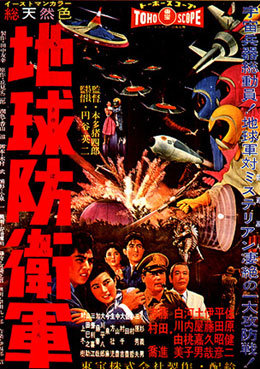 As
with the general theme conveyed in Godzilla's previous 28
films, the movie warns humankind about its unending push for
modernization.
As
with the general theme conveyed in Godzilla's previous 28
films, the movie warns humankind about its unending push for
modernization.
Kitamura sees Godzilla's message over the years
as being very simple: "I think when you look back over
time at the bad things that people do to each other, that
countries do to each other, and that races do to each other
you will see that they are pretty much unchanging. Although
Godzilla gets his message across in a very strange way, by
destroying everything in sight, basically what he is saying
is don't hurt other people, don't do bad things.
"I think that people are basically very
small beings, and it is because we are small beings that we
fight amongst each other. I think, although Godzilla is something
we created, in many ways he is much bigger than us. And by
looking perhaps at us through his eyes he shows us that we
are very small and the things that we are doing are very small."
The 1954 debut Godzilla, which sold
9.61 million tickets (second only to the 12.6 million sold
for King Kong vs. Godzilla), sees the scaly beast emerging
from the ocean as a result of nuclear testing, a direct allusion
to the hydrogen
bomb experiments the U.S. had been performing in the South
Pacific. One such experiment radiated a
Japanese fishing boat, resulting in the hospitalization
of all 23 sailors and the eventual death of one.
Two years later the film crossed the Pacific
in the form of Godzilla, King of the Monsters, an edited
version (dubbed in English) with the nuclear propaganda content
removed. In this version, 20 minutes of scenes with Raymond
Burr working as reporter Steve Martin was inserted as compensation.
This year saw the original Godzilla released in the
U.S. for the first time in its uncut form.
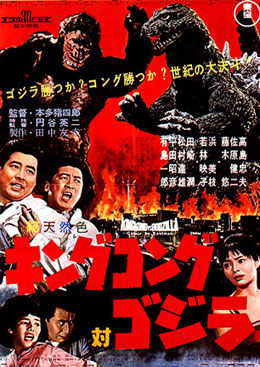 One
of reasons for the lizard's longevity, Tomiyama said, is due
to the charm of an actor being in the rubber suit. With the
exception of computer graphics used in the Columbia TriStar-produced,
box office failure Godzilla in 1998, the kaiju's tail
snaps and foot stomps have always been the result of an actor
living inside the latex.
One
of reasons for the lizard's longevity, Tomiyama said, is due
to the charm of an actor being in the rubber suit. With the
exception of computer graphics used in the Columbia TriStar-produced,
box office failure Godzilla in 1998, the kaiju's tail
snaps and foot stomps have always been the result of an actor
living inside the latex.
"People say modern technology could be
used," Tomiyama explained, "and I understand and
respect that kind of thinking but I personally feel that Godzilla
comes alive because there is a person inside. That is why
Godzilla has this great appeal and is loved throughout the
world."
The zip-up outfit
(entry behind the removable dorsal fins) is a beast all
its own. The 110-pound suit, first implemented by Toho special
effects man Eiji Tsuburaya, includes various wiring, a battery,
an air canister, peep holes, and a breathing tube in the neck.
"Japan has spent the last 50 years researching
and developing this very special technology which is a special
effects technology of using people in suits," said Kitamura
of Toho's advances, which often sees Godzilla overturning
models of train cars or kicking aside toy military tanks.
"I said from the beginning I wanted to avoid depending
on computer graphics. It's because there is a human being
inside that suit that you feel this kind of human energy bursting
out.
"Nowadays we have Japanese films that
are referred to as 'the Japanese version of Die Hard'
or 'the Japanese version of Speed.' In other words
Japanese films have had very low goals or aspirations. Of
course that is something that disappoints me greatly. This
(Toho's technology) is a way for us to kind of fight back,
to fight back against Hollywood films that use all this great
computer graphic technology, that uses so much money, that
has thousands of extras."
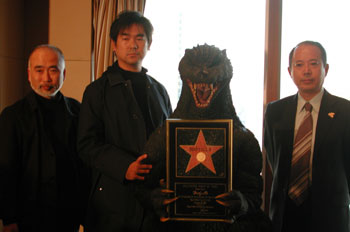 Tomiyama
is convinced that even if this is Godzilla's swan song, there
is a future in special effects for Toho. "I believe that
the special effects technology of Toho will be re-recognized
throughout the world. I look forward to an era not so far
distant where staff from the world over will assemble in Toho's
studios to make films with us together."
Tomiyama
is convinced that even if this is Godzilla's swan song, there
is a future in special effects for Toho. "I believe that
the special effects technology of Toho will be re-recognized
throughout the world. I look forward to an era not so far
distant where staff from the world over will assemble in Toho's
studios to make films with us together."
Godzilla has experienced a screen slumber a
number of times before. Most recently it took Toho nine years
to follow 1975's Terror of Mechagodzilla with The Return of
Godzilla.
Tomiyama, though, said that any future adventures
with Japanšs monster icon will not come from his current staff
and crew. "The next Godzilla film will be something created
by perhaps a new generation," he said, "and I will
be in the audience to appreciate it."
The Godzilla Series > Final Wars > Smog Monster

